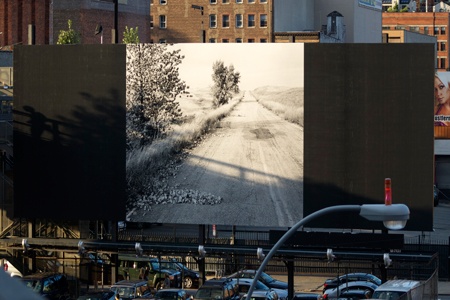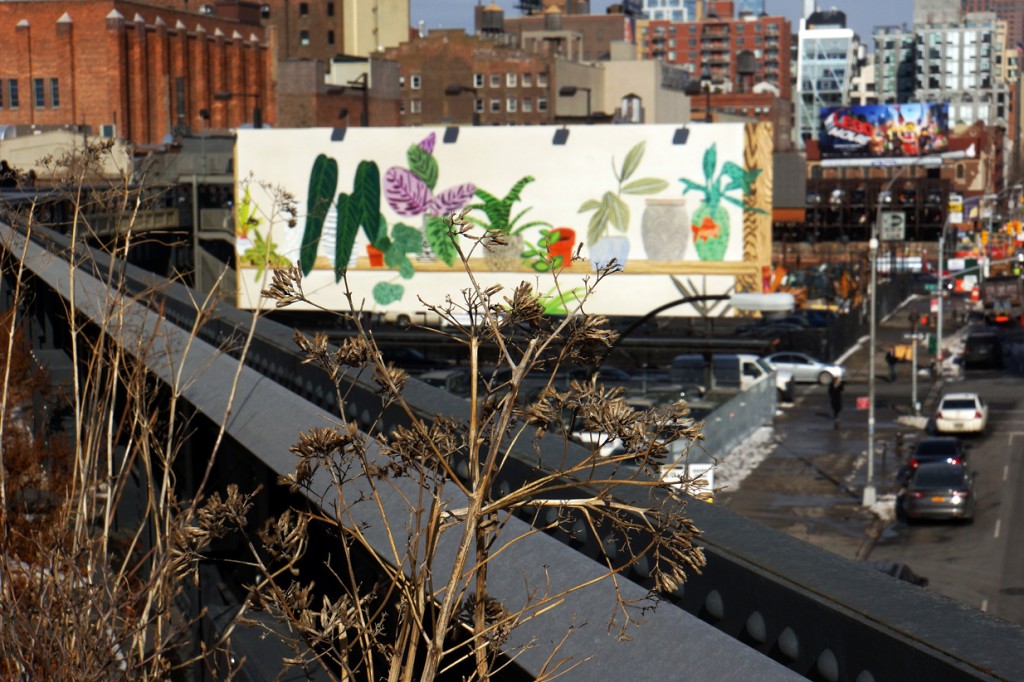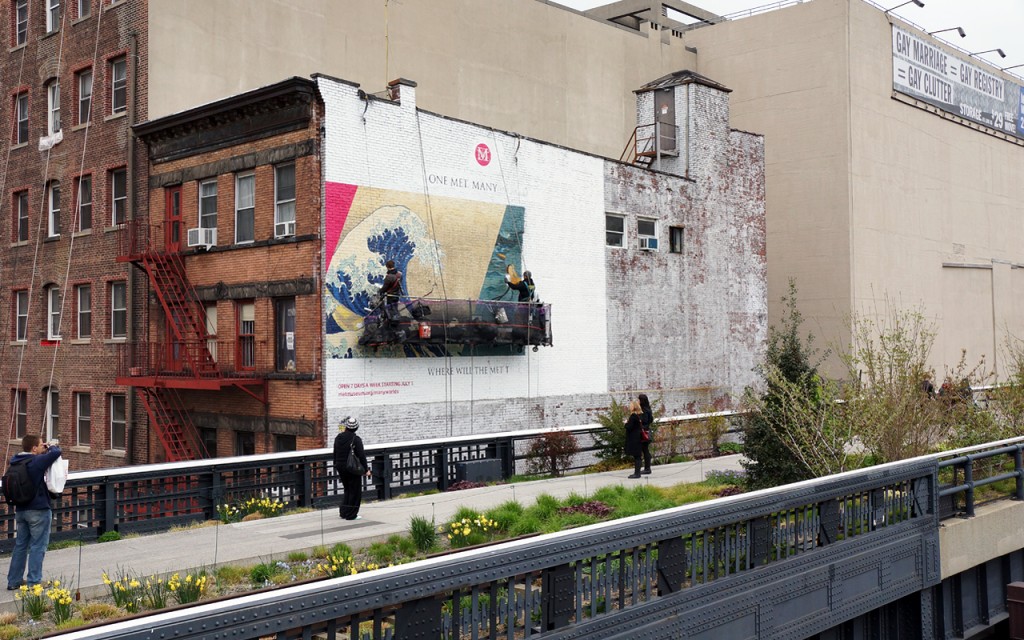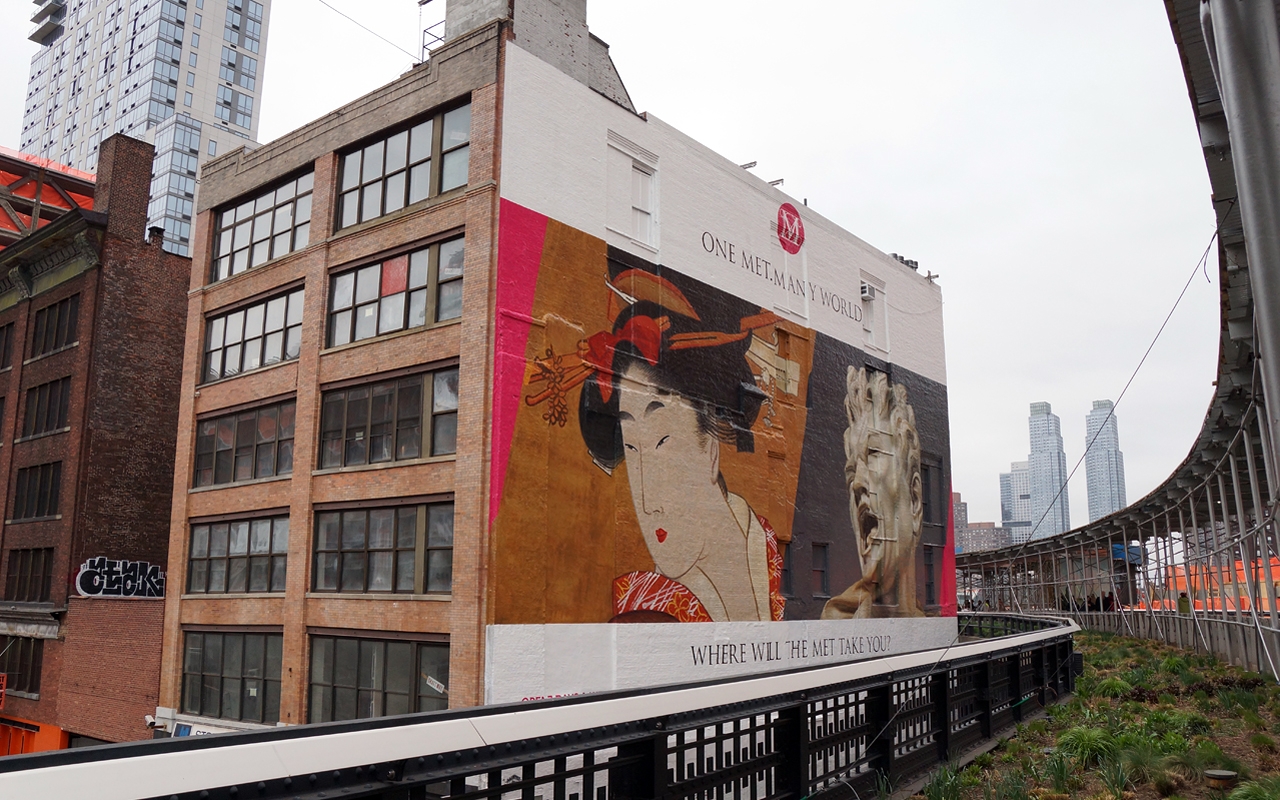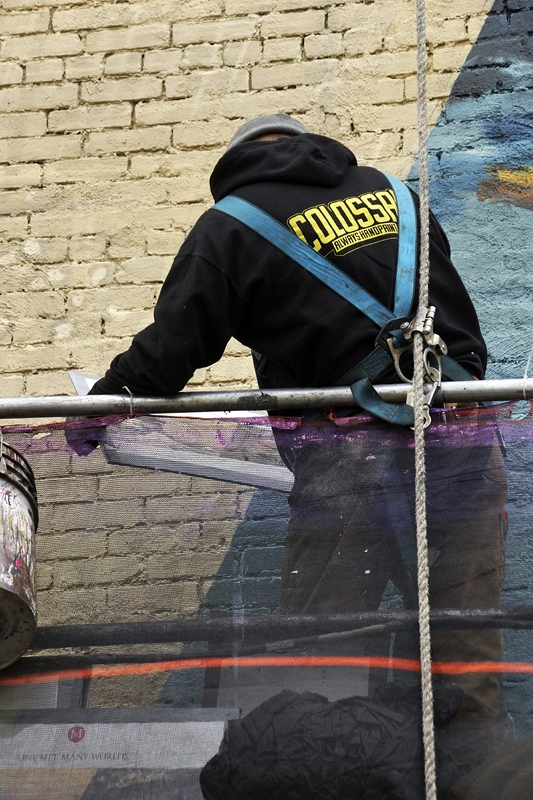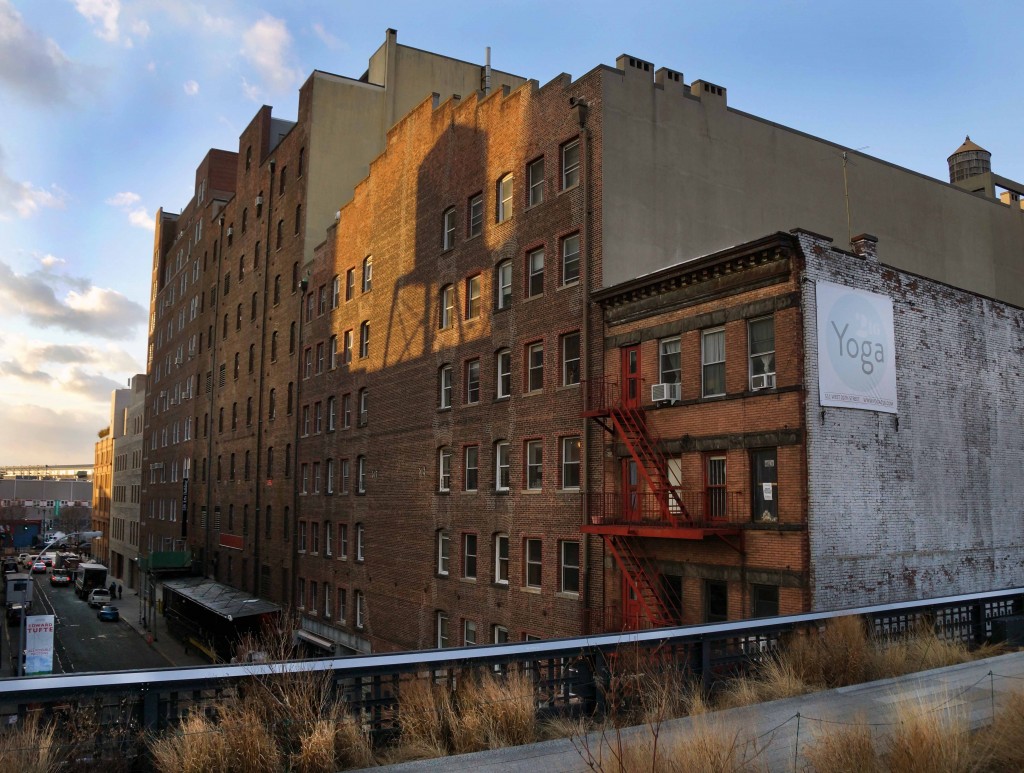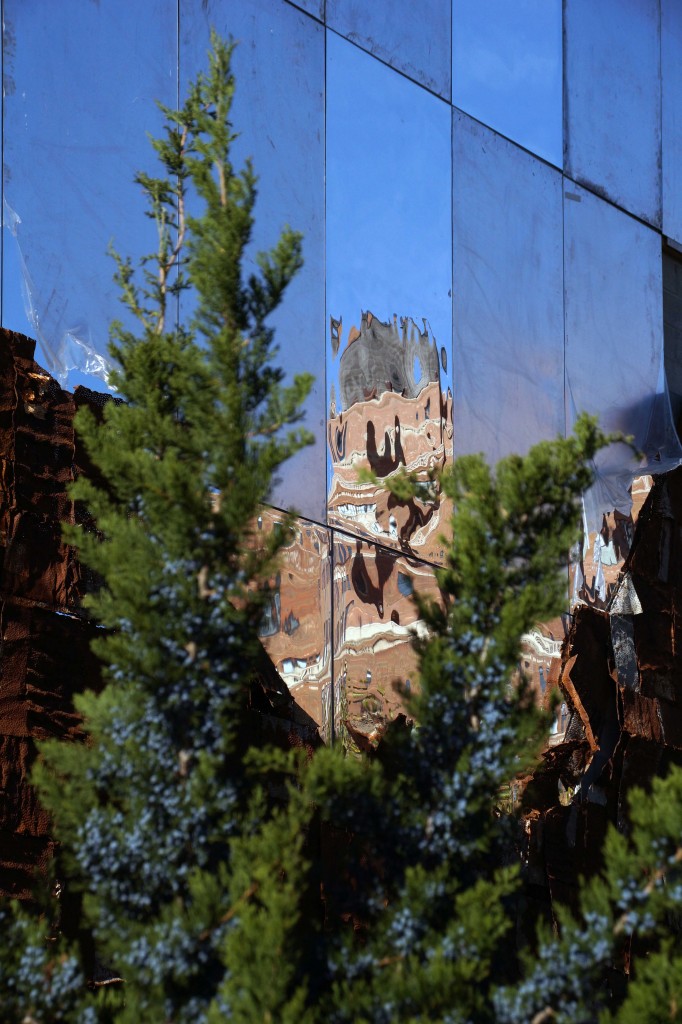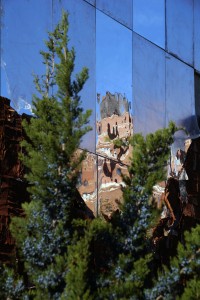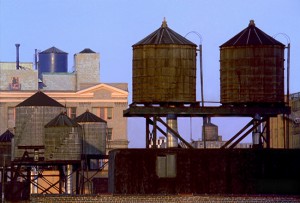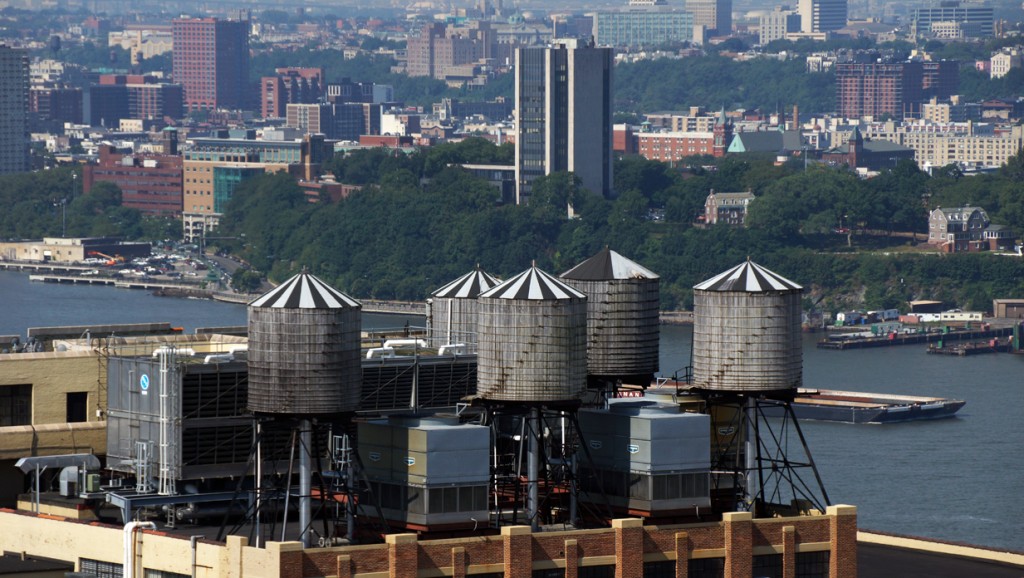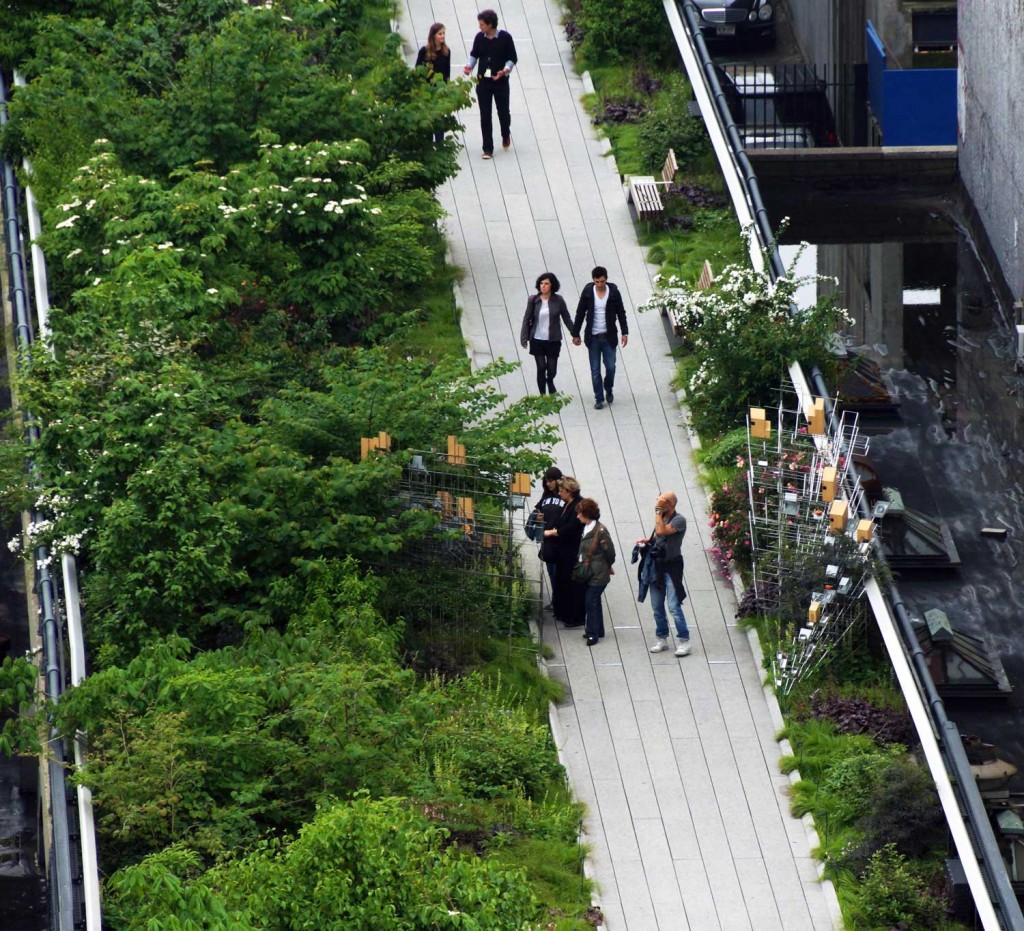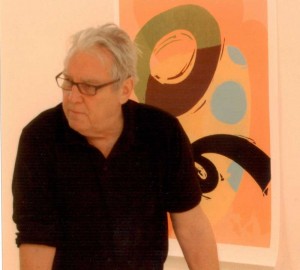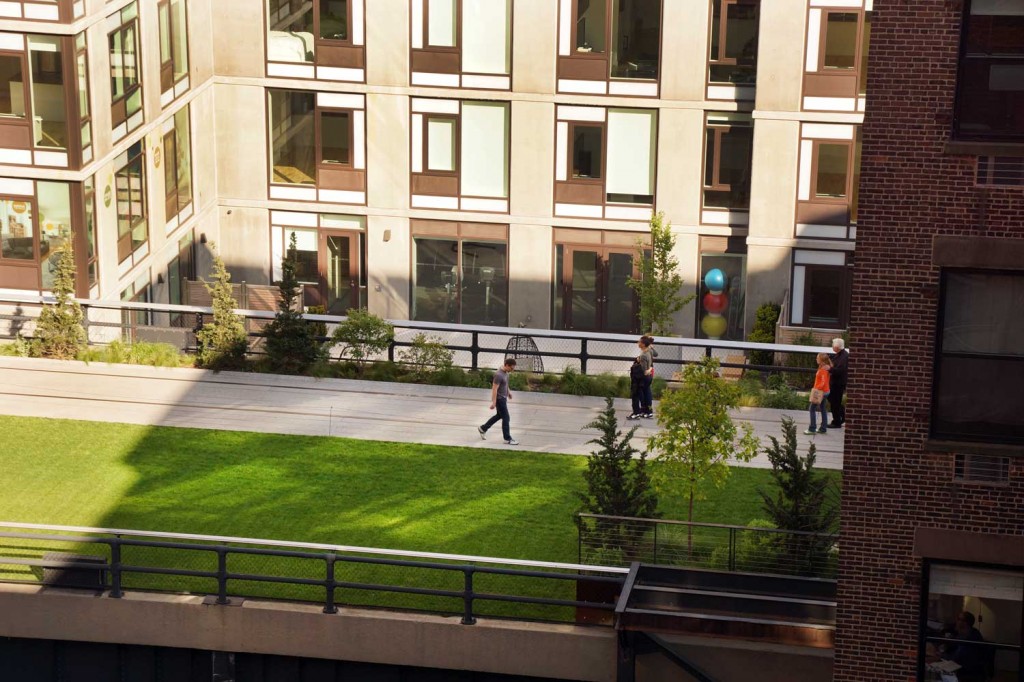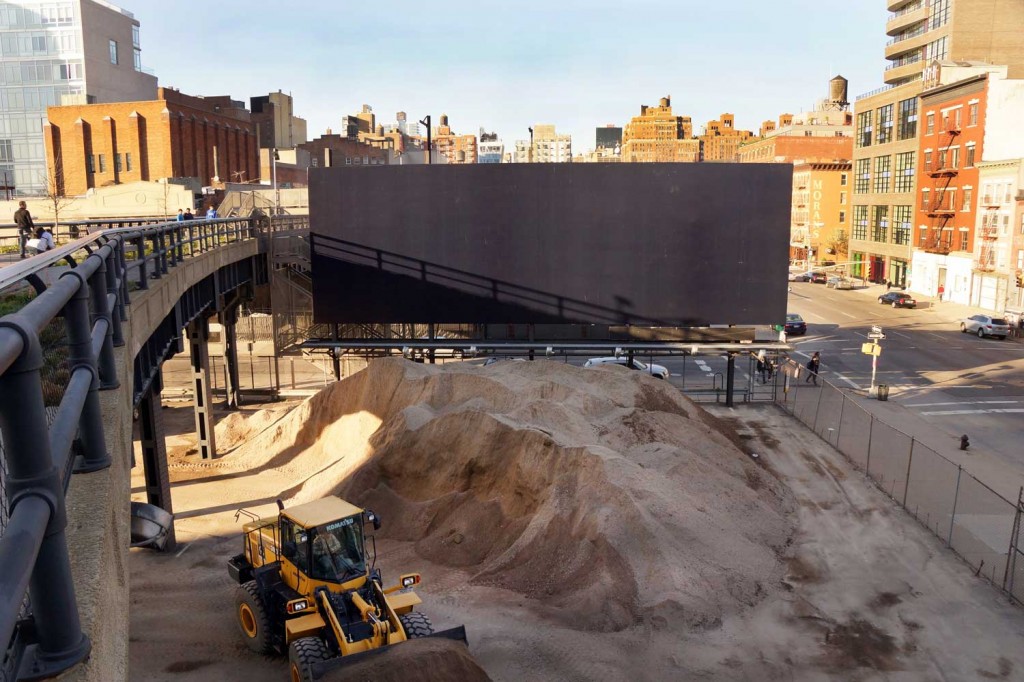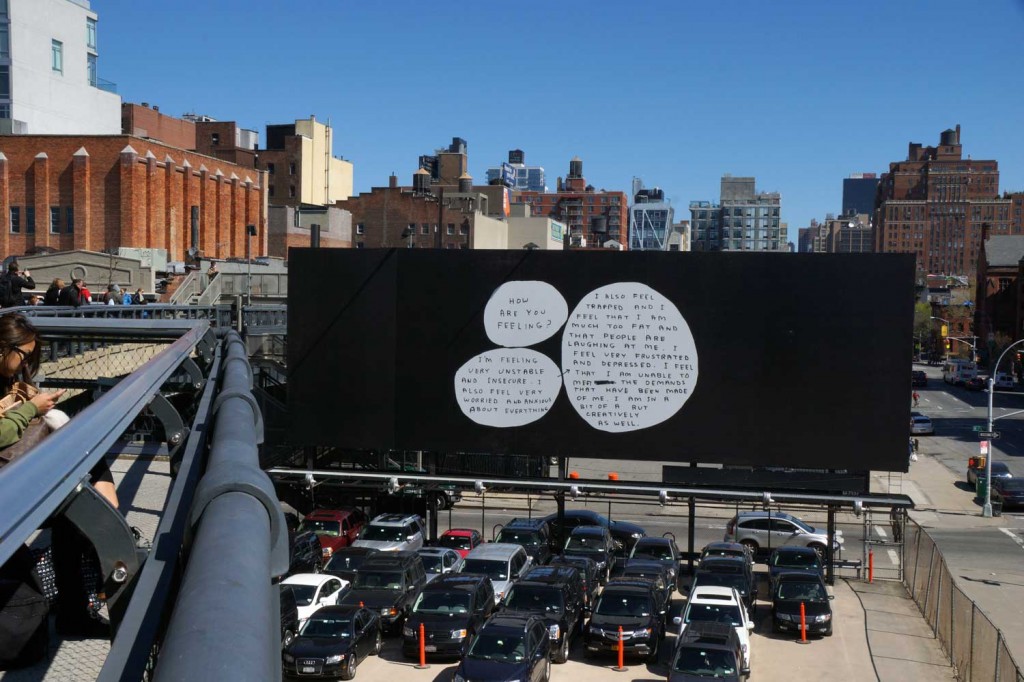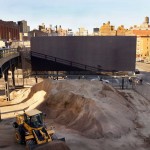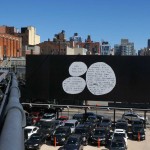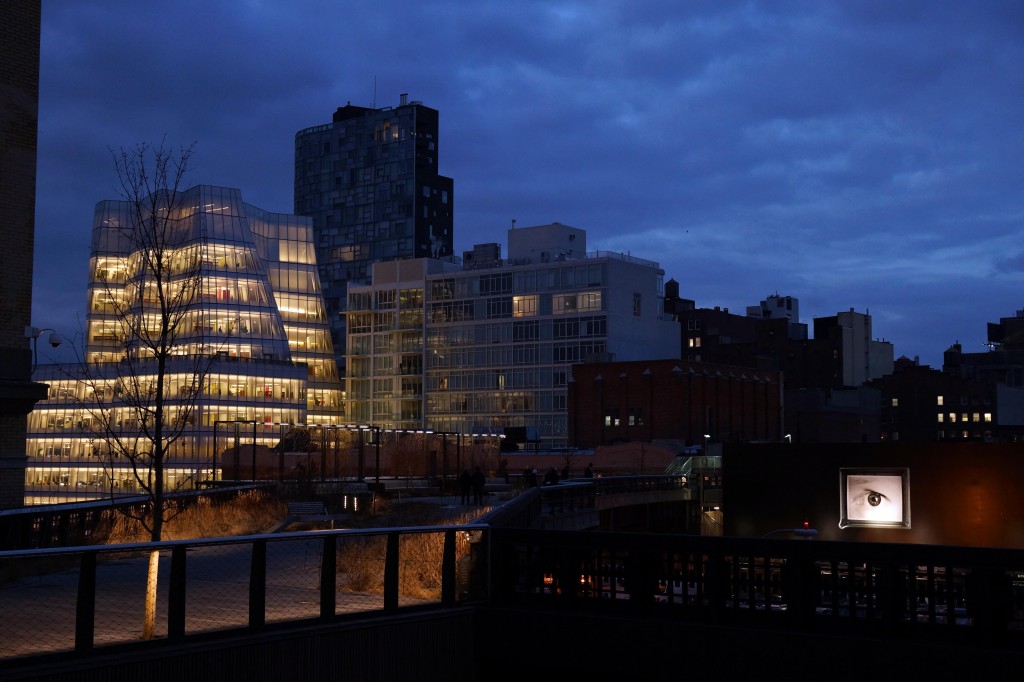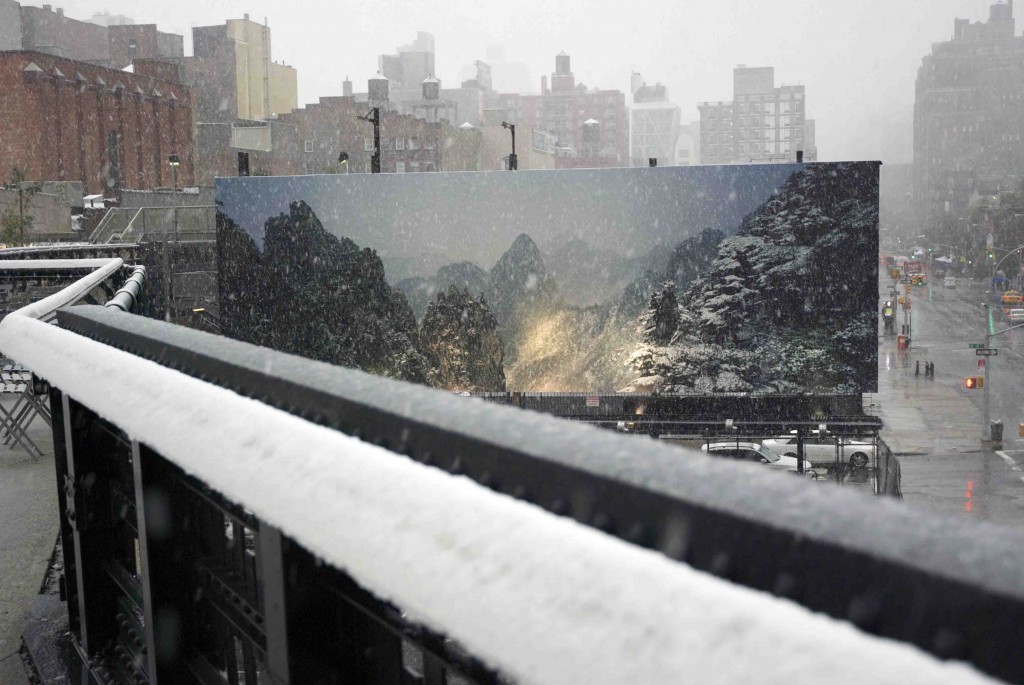This month’s installation on the 18th Street billboard is a perfect example of how a piece of public art can enliven and complement its environs. Jonas Wood’s “Shelf Still Life” has joined us in the midst of a bracing cold snap, and into this historic, arctic air sets before us a lovely view of plants in full bloom. It almost makes you want to unzip your jacket. These are house plants, so the work portrays an indoor scene, but as you walk by it the dead stalks of Compass plants and Prairie dock rise up to remind you that you’re in a real garden. The High Line is a place that’s filled with juxtapositions, and this work fits right in. It’s a playful seduction: colorful, blooming plants almost within reach, in the midst of a Polar Vortex. [continue reading…]
Art and the High Line
An amazing creative act is taking place right now on the High Line. If ever there was a reason to leave your desk and head out to the park, this is it. But go now, because it’ll be over soon.
Painters from a company called Colossal Media are working on a scaffold at 20th Street to paint a large ad for the Metropolitan Museum of Art. I took a walk in the park yesterday, starting at 30th Street, where I immediately encountered a perfectly gorgeous mural on the side of an apartment building. This is the same wall where the artist JR did a huge pasting of Brandon Many Ribs from the Lakota Tribe as part of the Inside Out Project a year ago.
What’s so unusual about this Met ad is its richness and texture. I wanted to crawl over the railing and touch it, to see if it was real. It’s mesmerizing because it looks it like an actual painting, but it’s not hanging in a museum: it’s outdoors, painted on brick, concrete and a bit of glass (the windows of the building). You can see brushstrokes. It’s downright painterly. I stood there wondering: in this day and age, would anyone really paint an ad on a building?
Farther south I found my answer. Colossal Media — which includes its logo in the work — is painting a second piece for the Met, this time a beautiful seascape that looks like a Hokusai. They’re still at it this morning, but they’re about halfway through.
Colossal Media is an advertising company that specializes in hand-painted work. I found a short film by Malcolm Murray (watch it here on Vimeo) in which an old-timer and a few current employees talk about the unusual craft they practice. One guy gives a perfect explanation for why the effect is so startling. Regular advertisers, with their printed billboards, “can’t print what we paint,” he says. “They print in pixels, they mix colors optically, little dots. You know, blue and yellow together makes green. But we paint green, so we can make it a lot richer.”
The men speak about the apprenticeship behind the craft, a two-year process in which the young painters are commanded to watch and absorb. One describes how he wasn’t allowed to paint for two full years. Today, he aspires to become both a good painter and a good teacher.
They talk about how difficult it can be, when the wind blows hard and the entire rig sways 30 feet to one side. “It takes so much work that it’s kind of ridiculous,” one guy comments. But “It’s the way Michelangelo did the Sistine Chapel: he made patterns, used charcoal, mixed his own paint. There’s no easy way to do it, it’s just the way it is.”
So right now you — I mean, really, right now — you have the opportunity to see this act of creation live. It’s just fascinating; they stand on the rickety scaffold, brush in one hand and an image of the work they are copying in the other. Perhaps this was a common sight in another century. Look up as you walk through the city streets and you’ll see the faded lettering of old hand-painted signs everywhere. In this neighborhood, around the High Line, you tend to see a lot of ads for printing and lumber companies, which were once prevalent here. A building on the north corner of 11th Avenue and 20th Street was recently torn down and above the rubble what suddenly appeared? An old hand-lettered sign. They are everywhere, hiding in plain sight.
Watching these men at work yesterday made me think the world would really be a better place if every advertisement were hand-painted. As I’ve said before: Run, don’t walk.
Who doesn’t love a New York City water tank? This iconic rooftop emblem is famous around the world, a standard bearer for our skyline. Recently — and from the High Line, my favorite observation deck — I’ve discovered a new way to appreciate these “silent sentries,” as the filmmaker Jane Martin calls them: in reflection.
Yesterday I took a stroll during the last half hour the park was open, and heading for the 20th Street stairs noticed this fine shadow on the old Baker & Williams warehouse. Spindly but clear, it’s a water tower that got caught in the setting sun, like a giant arachnid, and for a few minutes its skeletal outline was broadcast upon this old brick warehouse. This is a complex of buildings I’ve been photographing for years; it’s not particularly beautiful (although the water tower makes it so) but it has an unusual backstory that can be traced to the founding of New Amsterdam in the 17th century.
The first Dutch settlers on this island were entrepreneurs; they came here to do business. Their founding venture was to enable trade — primarily in beaver pelts — for the Dutch West India Company. Reports of the city’s earliest days include mention of warehouses “for storing furs and transferring them to ships.” The book Dutch New York describes the active commercial waterfront of 1664 as “rows of closely built brick, stepped, or spout-gabled townhouses and warehouses.”
Since the Industrial Revolution warehouses have been an essential part of West Chelsea, fueled by two key factors: the explosion of foreign and domestic trade on the Hudson River waterfront and passage of the Warehousing Act of 1846, which allowed private companies to warehouse goods and defer the payment of fees or taxes until products had been reshipped or picked up by the consignee. Defending that law twenty-five years later, the Storekeeper of the Port of New York noted that England’s similar arrangement “made her the mistress of the commerce of the world,” a position New Yorkers have vied for since the days of Henry Hudson.
The three brick buildings on 20th Street just west of the High Line once belonged to the Baker & Williams Company, which operated “bonded,” or duty-free, warehouses around the city as a direct benefit of the 1846 law. It’s also the site that helps explain how the Manhattan Project got its name. In the 1940s this set of buildings was used as a top-secret government facility for storing tons of processed uranium, which was being studied as part of the research effort that led to the production of the atom bomb. This was one of at least ten locations in Manhattan that participated in the atomic energy project; today it houses galleries and related businesses, and sits directly across the street from a house of worship, the Kingdom Hall of Jehovah’s Witnesses, and next door to the headquarters of Friends of the High Line. (For more, read William Broad’s fascinating article in the New York Times, “Why They Called it the Manhattan Project”)
The water tower that’s projected onto the warehouse also hails from a distant lineage and embodies a craft much more ancient than our metropolis. The great CBS newsman Charles Kuralt looked up at these structures and saw “the hoops and staves of the Middle Ages.” Everywhere in New York, it seems, are the shadows of history.
Below is another water tank in reflection, but this time from a thoroughly modern installation: the El Anatsui sculpture “Broken Bridge II,” that’s mounted on a building facade at 22nd Street. The tank it reveals is one of my favorites in the city; look a bit north and to the east and you’ll see it on the roof of the London Terrace Apartments on 23rd Street. That building also has a great backstory, but I’ll leave it for another day. (Or, you can read about it in my book, available for sale on the official website of Friends of the High Line!)
“So atop the city that taught the world what modern cities ought to be, there they are, the hoops and staves of the Middle Ages.” — Charles Kuralt
This blog is no danger of becoming LivinTheWaterTower.com, Scout’s honor, but I’ve had such an interesting response to recent pieces about New York’s water towers that I wanted to share what fellow tank enthusiasts have passed along.
I had no idea, until I learned about the Water Tank Project and started paying closer attention, that New York’s water towers have for many years been a source of artistic expression for a wide variety of artists. When the Water Tank Project opens next Spring New Yorkers will have the pleasure of seeing hundreds of tank-inspired works of art on display all over the city, by both established and emerging artists. Until then, here’s a few earlier works to enjoy. I’ll continue to update this list. If you have a work you’d like to tell me about, please email me using the contact form.
My photo captures the reflection of the beautiful brick structures that house the water tanks of the London Terrace apartments in the pressed tin and mirrors of El Anatsui’s installation-in-progress on 21st Street. The work is called Broken Bridge II and is part of the High Line’s excellent public art program. Read more about it here. I walked the High Line today and, to my delight, noticed this natural, impromptu blending of art + water towers. As always, click the image to enlarge it.
“Silent Sentries,” a short documentary by Jane Martin. The person who wrote to me about this film, which originally aired on PBS about 20 years ago, remembered a Greek chorus of New Yorkers who, when asked what the water tanks were, came up with a host of perfectly ridiculous but often marvelous (in that Only-in-New York kind of way…) answers and speculations. I found Jane Martin on the web and and she very kindly mailed me a DVD of the film. Yes, the comments from our fellow citizens are amusing, but what I loved about this film is the narrative that Martin un-spools. Somehow she managed to find and film the renovation of one water tank — it’s on the West Side, somewhere in the 50s, I think, but it’s hard to know for sure — and her film roughly documents the removal of the existing tank and its replacement with a brand new one. Her shots of the men at work are wonderful — often they seem completely unaware of the camera — and best of all you get the vivid (and sometimes vertiginous) sensation of actually being on the roof of a New York building and seeing the city from the point of view of a water tower. You also get a deep understanding of how these things are constructed. I suppose this shouldn’t have surprised me, but I was fascinated to realize that the water tanks have to be built on-site, they can’t simply be lifted up by a crane and installed ready-made. So while the modern city hums below, these beefy, expert guys practice a centuries-old art on the rooftops above. It’s a vivid and surprising film, and while it’s not currently available for streaming you can contact Jane via this email address about purchasing a copy: SilentSentries@janemartinart.com. For more about the film, visit JaneMartinArt.com. I hope that PBS will re-air the film next year when the Water Tank Project goes up.
“The Water Tower Player” (“Le Joueur de Citernes”) a film made by French filmmaker Emmanuel Gorinstein. Read my blog post about the film here, or go directly to Vimeo to watch it. Be ready for magic.
Tom Fruin’s Watertower, Dumbo, Brooklyn. Installed June 2012. This sculpture sits on the rooftop of 20 Jay Street and is visible from the Dumbo section of Brooklyn as well as the Brooklyn and Manhattan Bridges, the FDR Drive, and points in Lower Manhattan. The piece is made from reclaimed materials: steel plus roughly 1,000 scraps of salvaged plexiglass in every color of the rainbow, and is part of series of works that pay tribute to architectural icons around the world. The sun lights the piece by day, and at night it’s lit by Arduino-controlled light sequences designed by Ryan Holsopple. Read more about it and see gorgeous photos — shot in daylight and at night — on TomFruin.com.
Rachel Whiteread’s Water Tower, SoHo, New York. According to the Museum of Modern Art’s website, British artist Whiteread was commissioned by the Public Art Fund in 1998 to create this work of public art, and she “scoured the city in search of a quintessentially New York subject.” Like many artists, she looked up and saw water towers, and conceived this sculpture, which is a resin cast of the interior of a once-functioning cedar water tank. According the MoMA website, “The translucent resin captures the qualities of the surrounding sky; the sculpture’s color and brightness change throughout the day and it becomes a near-invisible whisper at night.” Whiteread has called the work “a jewel on the skyline of Manhattan.” The sculpture now sits on the roof of MoMA, so you can check it out yourself next time you’re there. Read more and see a photograph on MoMA.org.
Readers of this blog know that I love New York’s water towers. One of the most-read posts in the archive is a piece about Charles Kuralt, the great CBS newsman who also adored the “hoops and staves of the Middle Ages” that define our city skyline.
Next spring a new public art project will pay tribute to our water towers, sponsored by a group called Word Above the Street, a non-profit that uses art to advocate for social justice and sustainability. The idea for the water tower project followed a 2007 trip to Ethiopia by filmmaker Mary Jordan, who realized that one of the severest problems in Africa is that water might be abundant but “it was never in the right place.” The people of Ethiopia lacked containers — buckets, bottles — to transport the water from its source to their homes. She returned determined to launch a campaign about the scarcity of water, and in time, the Water Tank Project was conceived.
For six weeks in Spring 2013 hundreds of water towers all over New York City will be transformed by established and emerging figures in art, music and science. A contingent of students from the city’s public schools will also be involved. [continue reading…]
Last week I received an email from a high school student in Bangladesh named Tinni Bhattacharyya. There, nearly 8,000 miles from 21st Street on Manhattan island, she has launched a campaign to make Sarah Sze’s sculpture “Landscape With Still Life” a permanent fixture on the High Line.
Tinni created a Facebook page for the campaign, where she writes:
Sze’s installation has become an integral part of the Highline’s ecosystem. Sze’s installation has evolved from an architectural frame to an organic living environment that is embedded in the ecosystem. While “Still Life with Landscape, Model for a Habitat” has been scheduled to be taken down on June 8th 2012, this campaign has been launched to preserve Sze’s piece in order to support the community of animals it has founded.
Tinni was born in New Delhi, but her father is a diplomat and so she grew up all over the world — in Belgium, China, Japan, and now Bangladesh. She first saw the High Line last summer when she was interning in New York. She told me that she had the opportunity to spend some time working in Sarah Sze’s studio, where she witnessed the process behind the creation of Sze’s pieces and came to understand the concepts the artist explores in her work. Tinni is motivated by the beauty of the artwork as well as its success as a habitat for many kinds of birds and insects. And her campaign is well underway; the Facebook page is fast accumulating comments, photos, and Likes.
I hope that Tinni succeeds. “Still Life With Landscape” is one of my favorite exhibits in the High Line’s public art program. Its Palladian lines and geometric shapes are strikingly, quietly, beautiful and even more, it brings the birds close to us, just inches away. In a big city with too many humans, this is a small blessing.
For more about Sarah Sze, visit the artist’s website. Go here to learn more about the High Line’s public art program. Join Tinni’s campaign on Facebook, here.
One of my favorite things about the High Line is the presence of public art throughout the year, in every season and in every form, media, and style. Friends of the High Line committed itself from the very beginning to introducing the work of new artists as well as established ones, and the program — first run by Lauren Ross and today by Cecilia Alemani — has won awards and immense popularity from visitors. The neighborhood the park traverses has long been a vibrant center of the arts, with visionary institutions — The Kitchen, Dia Art Foundation, Printed Matter, Exit Art — as well as hundreds (more than 400 at last official count) of commercial art galleries. The Whitney is building a new home, designed by Renzo Piano, at the southern end of the High Line, and Dia is constructing a large new exhibit space on 22nd Street. When those two projects are completed, the High Line’s neighborhood will arguably be the most important concentration of contemporary art in the United States.
The influence of the High Line’s art program will soon be visible in a new venue. On Mother’s Day the luxury rental complex known as Ten23, between 22nd & 23rd Street on Tenth Avenue, will install a piece of sculpture by the artist Charlie Hewitt. Called “Urban Rattle,” the work will stand some 20′ high in the center of the building’s patio, just below and on the eastern edge of the park. Hewitt is an American artist (born 1946) whose work includes paintings, sculpture, engraving, woodcuts, print-making and other media. His work has been acquired for collections in the Metropolitan Museum of Art, MoMA, the Whitney, Brooklyn Museum, New York Public Library and the Library of Congress.
Emily Santangelo, the art consultant who arranged the project with Equity Residential, the building’s owner, describes it as “the first privately commissioned monumental sculpture to directly address the High Line and its community of visitors.” She says that Hewitt considers his work to be “doodles in steel,” and describes “Urban Rattle” as “playful and serious at the same time.” This seems a perfect combination, as the work will hover over the High Line’s lawn, a place of mixed use where children run, leap, and often screech with joy while adults read or engage in quiet conversation.
If you’d like to watch the installation, it will take place over the weekend, beginning on Saturday, May 12 and ending on Sunday afternoon. I’m told that the members of the FDNY’s (controversial) EMT station under the High Line will be lending a hand as the steel structure is unloaded and carried up to the patio.
As readers of this blog know, I documented the progress of Ten23 for almost three years as I was writing about the construction of section two of the High Line. The lawn — and the apartment complex — appear just outside my window, and were built in tandem. Photos of Hewitt’s piece will follow in a week or so. Meantime, here’s what it looks like today:
To learn more about the High Line’s public art program, visit the website of Friends of the High Line. To learn more about Charlie Hewitt, visit the author’s website or EmilyFineArt.com.
NOTE: this posted has been updated
The billboard on 18th Street has probably been empty before, but I’ve never seen it, and certainly not as it is now, starkly black. It’s really quite striking: it shows an absence of advertising, which makes you consider what life might be like if we weren’t bombarded at every turn with ads and marketing promotions. This is the billboard that has displayed so many wonderful photographs as part of the High Line’s public art program (launch the slideshow below to see photos). When there’s not a beautiful or provocative image — like Anne Collier’s “Developing Tray,” which was on display in February — there’s often some humorous message from Edison Parking, which owns the lot below. My favorite: “Stop praying, God’s too busy to find you a parking space.”
Today, however, the billboard is empty. Last evening men in large machines were removing the giant pile of dirt that was part of a car company’s recent marketing stunt. Whatever. What’s cool about the billboard today is how the inky black background invites a lovely shadow of the High Line’s railing. If you stand there for awhile and watch the people walk by you’ll eventually see their shadow heads pass in the billboard, as if in a cartoon. Art often reflects our world and returns it to us in a different, altered form, for our consideration. In a way that’s what this empty billboard is doing now. There’s something blissfully simple and peaceful about it. Check it out in the late afternoon when the sun casts its shadow and you’ll see what I mean. Enjoy it while it lasts. No doubt it won’t be long before the advertisers return.
UPDATE, April 6: shortly after I wrote this post the newest installation in the 18th Street Billboard art project was completed. It’s called “How Are You Feeling?” by David Shrigley. I took my photo in late morning sun, so no shadows, but I suspect you may still see them in the late afternoon against the black background. Read more about the piece and the artist here, on TheHighLine.org.
- David Shrigley, “How Are You Feeling”?
Anne Collier’s photograph”Developing Tray #2,” now featured on the High Line Billboard at 18th Street, is a ringing testament to the power of the High Line’s art program. This piece didn’t strike me when I first saw it a few weeks ago, in broad daylight, but lately I’ve been visiting the park at dusk, and wow, what a difference an evening makes.
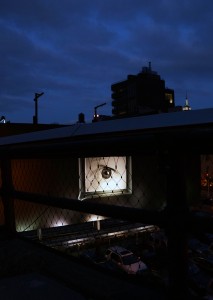
The work is so spare and simple that it stands out quite dramatically in the busy viewscape of buildings, car headlights, and rowdy billboard ads around it. But what makes Collier’s image such a great example of the power of public art is the way you can overlay your own ideas onto it. And the High Line makes the perfect foil. I’m not a good enough photographer to create anything worthwhile, but I’ve had great fun framing the eyeball through the railings. Every view is different, and every angle offers a new surprise.
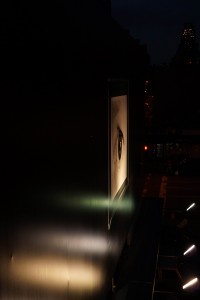
I’ve loved all the photographs in the Billboard program, but didn’t realize until recently how and why these photos work so well in their unique setting. Darren Almond’s FullMoon@TheNorthSea, a photograph that portrays the Huangshan mountain range in China on the evening of a full moon, was on display last year. I happened upon it one day during a rare October snow storm, which animated the billboard and transported everyone who saw it into another world altogether.
This billboard (when it’s not displaying a humorous slogan for the parking lot below it) makes you realize how different it is to see a work of art in a public space versus a museum or a gallery. The High Line’s commitment to public art is a boon to us all.

I love the (relatively) new billboard on the High Line, which is part of the park’s great public art program. Joel Sternfeld selected Robert Adams’ black & white photograph of a highway in Nebraska, titled “Nebraska State Highway 2, Butte County” and it will remain on the billboard over the giant parking lot on 18th Street until the end of this month.
The High Line’s website explains that Adams made this image in 1978 “as part of a survey to discover how the grand landscapes of the western United States had been shaped, in ways both subtle and dramatic, by human development.” The empty road makes a strong contrast with our own “grand landscape” of Manhattan, towering majestically above Tenth Avenue where an endless stream of taxis, cars, motorcycles, trucks, bicycles, pedicabs, razors, and dudes on skateboards goes rolling by, day and night.
But I noticed something else when I looked at some photographs I took a few weeks ago: you can see the shadows of people walking along the High Line in the photograph. I have no idea if this was intentional, but Sternfeld understands better than anyone the way the sunlight dances on and around this park.
So there we are, walking along Robert Adams’ deserted Nebraska highway: yet another connection the High Line makes for us between the canyons of Manhattan and the prairies of the American west.
